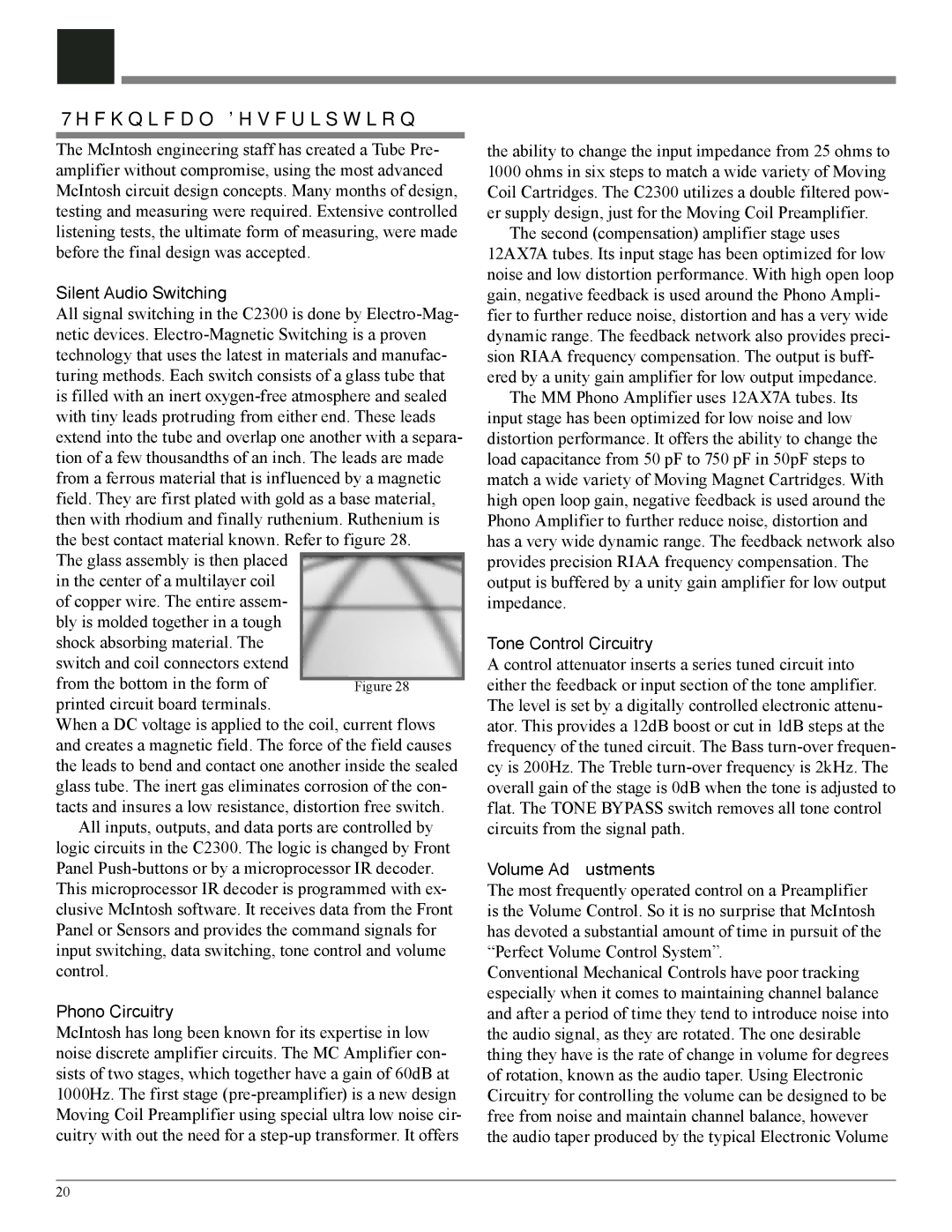
Technical Description
The McIntosh engineering staff has created a Tube Pre- amplifier without compromise, using the most advanced McIntosh circuit design concepts. Many months of design, testing and measuring were required. Extensive controlled listening tests, the ultimate form of measuring, were made before the final design was accepted.
Silent Audio Switching
All signal switching in the C2300 is done by
The glass assembly is then placed in the center of a multilayer coil of copper wire. The entire assem- bly is molded together in a tough shock absorbing material. The switch and coil connectors extend from the bottom in the form of printed circuit board terminals.
When a DC voltage is applied to the coil, current flows and creates a magnetic field. The force of the field causes the leads to bend and contact one another inside the sealed glass tube. The inert gas eliminates corrosion of the con- tacts and insures a low resistance, distortion free switch. All inputs, outputs, and data ports are controlled by logic circuits in the C2300. The logic is changed by Front
Panel
Phono Circuitry
McIntosh has long been known for its expertise in low noise discrete amplifier circuits. The MC Amplifier con- sists of two stages, which together have a gain of 60dB at 1000Hz. The first stage
the ability to change the input impedance from 25 ohms to 1000 ohms in six steps to match a wide variety of Moving Coil Cartridges. The C2300 utilizes a double filtered pow- er supply design, just for the Moving Coil Preamplifier.
The second (compensation) amplifier stage uses 12AX7A tubes. Its input stage has been optimized for low noise and low distortion performance. With high open loop gain, negative feedback is used around the Phono Ampli- fier to further reduce noise, distortion and has a very wide dynamic range. The feedback network also provides preci- sion RIAA frequency compensation. The output is buff- ered by a unity gain amplifier for low output impedance.
The MM Phono Amplifier uses 12AX7A tubes. Its input stage has been optimized for low noise and low distortion performance. It offers the ability to change the load capacitance from 50 pF to 750 pF in 50pF steps to match a wide variety of Moving Magnet Cartridges. With high open loop gain, negative feedback is used around the Phono Amplifier to further reduce noise, distortion and has a very wide dynamic range. The feedback network also provides precision RIAA frequency compensation. The output is buffered by a unity gain amplifier for low output impedance.
Tone Control Circuitry
A control attenuator inserts a series tuned circuit into either the feedback or input section of the tone amplifier. The level is set by a digitally controlled electronic attenu- ator. This provides a 12dB boost or cut in 1dB steps at the frequency of the tuned circuit. The Bass
Volume Adjustments
The most frequently operated control on a Preamplifier is the Volume Control. So it is no surprise that McIntosh has devoted a substantial amount of time in pursuit of the “Perfect Volume Control System”.
Conventional Mechanical Controls have poor tracking especially when it comes to maintaining channel balance and after a period of time they tend to introduce noise into the audio signal, as they are rotated. The one desirable thing they have is the rate of change in volume for degrees of rotation, known as the audio taper. Using Electronic Circuitry for controlling the volume can be designed to be free from noise and maintain channel balance, however the audio taper produced by the typical Electronic Volume
20
